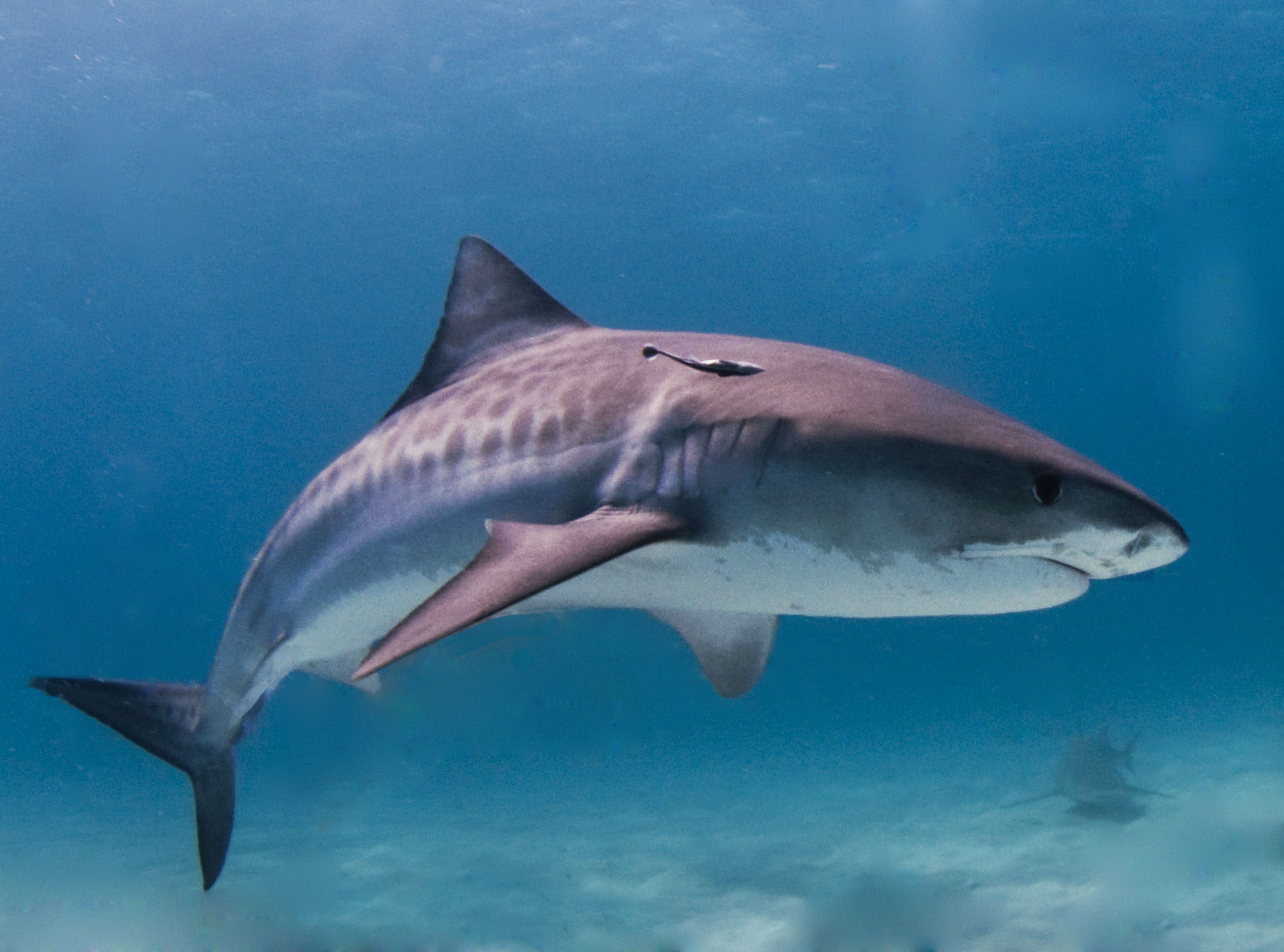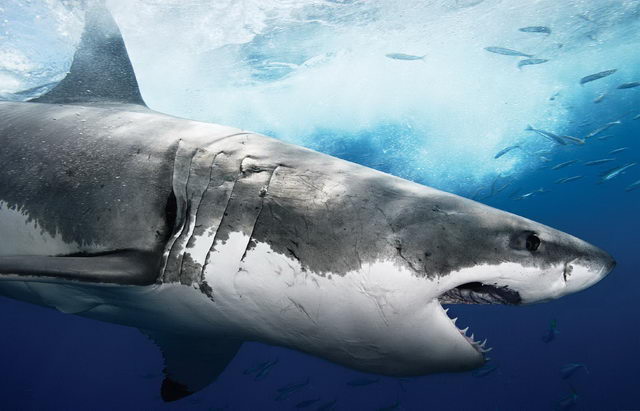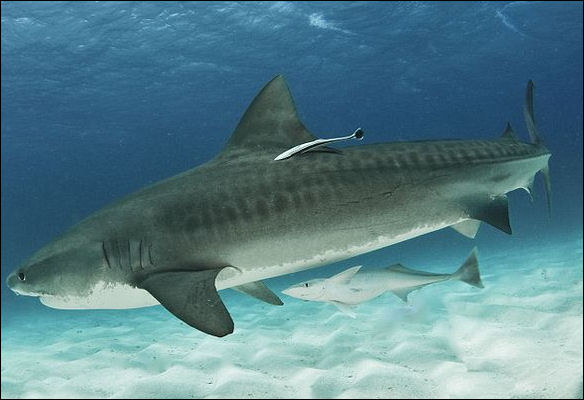Source(google.com.pk)
Shark Biography
Sharks are amazing fish that have been around since long before the dinosaurs existed. They live in waters all over the world, in every ocean, and even in some rivers and lakes.
Unlike bony fish, sharks have no bones; their skeleton is made of cartilage, which is a tough, fibrous substance, not nearly as hard as bone. Sharks also have no swim bladder (unlike bony fish).
SIZE
A scuba diver above a Whale shark. The Whale shark is the largest fish in the world; the basking shark is the second largest fish.
There are many different species of sharks that range in size from the size of a person's hand to bigger than a bus. Fully-grown sharks range in size from 7 inches (18 cm) long (the Spined Pygmy shark), up to 50 feet (15 m) long (the Whale shark). Most sharks are intermediate in size, and are about the same size as people, 5-7 feet (1.5-2.1 m) long. Half of the 368 shark species are under 39 inches (1 m) long.
VARIETIES OF SHARKS
There are about 368 different species of sharks, which are divided into 30 families. These different families of sharks are very different in the way they look, live, and eat. They have different shapes, sizes, color, fins, teeth, habitat, diet, personality, method of reproduction, and other attributes. Some types of shark are very rare (like the great white shark and the megamouth) and some are quite common (like the dogfish shark and bull shark). Sharks belong to the group of cartilagenous fish, the Elasmobranchii, that includes the sharks, rays, and skates.
TEETH
Sharks may have up to 3,000 teeth at one time. Most sharks do not chew their food, but gulp it down whole it in large pieces. The teeth are arranged in rows; when one tooth is damaged or lost, it is replaced by another. Most sharks have about 5 rows of teeth at any time. The front set is the largest and does most of the work.
--------------------------------------------------------------------------------
DIET
Sharks vary greatly in their diets, but they are all carnivores.
Some (like the great white, mako, tiger, and hammerhead) are swift predators that eat fish, squid, other sharks, and marine mammals.
Some (like the zebra horn shark, angelshark, and wobbegong) are slow-swimming predators that crush and eat shellfish (crabs and clams) from the ocean floor.
Others (like the whale shark, the basking shark, and the megamouth) are filter feeders that sieve tiny bits of plankton and small animals from the water as they swim with open mouths. They eat huge amounts of these tiny animals and plants.
--------------------------------------------------------------------------------
DO SHARKS SLEEP?
Fish don't sleep in the same way that we do, but they have active and inactive periods. Some sharks (like the nurse shark) have been observed resting motionless on the sea floor. Others have to keep moving in order to breathe.
--------------------------------------------------------------------------------
SHARK ATTACKS
When some sharks (like the Great White or the Gray Reef shark) turn aggressive prior to an attack, they arch their back and throw back their head. This places their mouth in a better position for taking a big bite. They also move their tail more acutely (probably in preparation for a chase).
Sharks do not normally attack people, and only about 25 species of sharks are known to attack people. Sharks attack fewer than 100 people each year. Many more people are killed by bees or lightning.
The sharks that are the most dangerous to people are the great white shark, the tiger shark, the bull shark, and the oceanic whitetip shark. The bull shark is the most frequent attacker of people as it swims in very shallow waters where people swim and is a very plentiful shark. Some of the other sharks that are known to have attacked people include the gray shark, blue shark, hammerhead shark, mako shark, nurse shark, lemon shark, blacktip reef shark, wobbegongs, sandtiger, spitting sharks, and the porbeagle. Some people believe that sharks mistake people (especially people swimming on surf boards) for seals and sea lions, some of their favorite foods.
--------------------------------------------------------------------------------
FEEDING FRENZY
Occasionally, a group of sharks will attack a food source (for example, a school of fish) in a maniacal fashion. They will wildly attack the food and anything in the area, even each other, sometimes wounding or eating fellow sharks.
--------------------------------------------------------------------------------
INTELLIGENCE
Scientists have shown that sharks are relatively intelligent and can learn at a rate similar to that of rats and birds.
--------------------------------------------------------------------------------
HABITAT
Sharks live in oceans and seas all over the world, and even in some rivers and lakes, especially in warmer waters. Some sharks live near the surface, some live deep in the water, and others live on or near the ocean floor. Pelagic sharks (living in the open ocean) include the great white shark, the basking shark, etc. Benthic sharks (living at the ocean floor) include the zebra horn shark, the wobbegongs, and the angelshark, which usually have flattened, camouflaged bodies that let them hide in the sea bed. Some sharks even venture many miles up into the fresh water of rivers like the Mississippi in the USA and the Amazon in Brazil. The bull shark (Carcharhinus leucas) sometimes ventures into fresh water.
Some sharks live in relatively warm waters (hammerheads, bull sharks, and tiger sharks). Other sharks, such as the thresher, mako, basking and blue shark, live in temperate water (which is neither hot nor cold). Others, including the dogfish, Greenland, and goblin, live in cool waters. Some sharks stay in the same region their entire lives while others travel across oceans.
--------------------------------------------------------------------------------
MIGRATION OF SHARKS
There are three different types of sharks when it come to migratory patterns:
Local sharks - these sharks do not migrate, and range only about a hundred miles from their habitat. Examples include the bonnethead shark, and the nurse shark.
Coastal pelagic sharks - these sharks can migrate over 1,000 miles (1,600 km). Examples include the dusky shark, the blacktip sharks, the tiger shark, and the sandbar shark.
Highly pelagic sharks - these sharks migrate across oceans. Examples include the blue shark and the mako.
--------------------------------------------------------------------------------
EVOLUTION OF SHARKS
Sharks have existed for over 350 million years. They evolved over 100 million years before the dinosaurs did. This was long before people evolved. Most fossil evidence of early sharks is from fossilized teeth and a few skin impressions. Cladodonts, primitive sharks, had double-pointed teeth, were up to 6 feet (2 m) long lived about 360 million years ago (mya); they ate fish and crustaceans.
For more information on early sharks, click here.
--------------------------------------------------------------------------------
EXTINCT SHARKS
Megalodon (Carcharodon megalodon) was an ancient, meat-eating shark, living between 25-1.6 million years ago; it is extinct. It was over 40 feet (12 m) long, but this is only an estimate from fossil teeth that have been found. Its teeth resemble those of the great white shark but are almost 3 times larger; these teeth are each the size of a person's hand!
Shark fossils are rare because sharks have no bones, only cartilage, which does not fossilize well. Fossilized shark teeth are very hard and fossilize well.
--------------------------------------------------------------------------------
ENDANGERED AND PROTECTED SPECIES
The Basking shark, a species in decline.
The largest sharks are decreasing in numbers around the world because of being hunted by people. The Great white shark, the Basking shark, and the Whale shark are all waning. The Great white is protected along the coast of California and South Africa.










Shark Biography
Sharks are amazing fish that have been around since long before the dinosaurs existed. They live in waters all over the world, in every ocean, and even in some rivers and lakes.
Unlike bony fish, sharks have no bones; their skeleton is made of cartilage, which is a tough, fibrous substance, not nearly as hard as bone. Sharks also have no swim bladder (unlike bony fish).
SIZE
A scuba diver above a Whale shark. The Whale shark is the largest fish in the world; the basking shark is the second largest fish.
There are many different species of sharks that range in size from the size of a person's hand to bigger than a bus. Fully-grown sharks range in size from 7 inches (18 cm) long (the Spined Pygmy shark), up to 50 feet (15 m) long (the Whale shark). Most sharks are intermediate in size, and are about the same size as people, 5-7 feet (1.5-2.1 m) long. Half of the 368 shark species are under 39 inches (1 m) long.
VARIETIES OF SHARKS
There are about 368 different species of sharks, which are divided into 30 families. These different families of sharks are very different in the way they look, live, and eat. They have different shapes, sizes, color, fins, teeth, habitat, diet, personality, method of reproduction, and other attributes. Some types of shark are very rare (like the great white shark and the megamouth) and some are quite common (like the dogfish shark and bull shark). Sharks belong to the group of cartilagenous fish, the Elasmobranchii, that includes the sharks, rays, and skates.
TEETH
Sharks may have up to 3,000 teeth at one time. Most sharks do not chew their food, but gulp it down whole it in large pieces. The teeth are arranged in rows; when one tooth is damaged or lost, it is replaced by another. Most sharks have about 5 rows of teeth at any time. The front set is the largest and does most of the work.
--------------------------------------------------------------------------------
DIET
Sharks vary greatly in their diets, but they are all carnivores.
Some (like the great white, mako, tiger, and hammerhead) are swift predators that eat fish, squid, other sharks, and marine mammals.
Some (like the zebra horn shark, angelshark, and wobbegong) are slow-swimming predators that crush and eat shellfish (crabs and clams) from the ocean floor.
Others (like the whale shark, the basking shark, and the megamouth) are filter feeders that sieve tiny bits of plankton and small animals from the water as they swim with open mouths. They eat huge amounts of these tiny animals and plants.
--------------------------------------------------------------------------------
DO SHARKS SLEEP?
Fish don't sleep in the same way that we do, but they have active and inactive periods. Some sharks (like the nurse shark) have been observed resting motionless on the sea floor. Others have to keep moving in order to breathe.
--------------------------------------------------------------------------------
SHARK ATTACKS
When some sharks (like the Great White or the Gray Reef shark) turn aggressive prior to an attack, they arch their back and throw back their head. This places their mouth in a better position for taking a big bite. They also move their tail more acutely (probably in preparation for a chase).
Sharks do not normally attack people, and only about 25 species of sharks are known to attack people. Sharks attack fewer than 100 people each year. Many more people are killed by bees or lightning.
The sharks that are the most dangerous to people are the great white shark, the tiger shark, the bull shark, and the oceanic whitetip shark. The bull shark is the most frequent attacker of people as it swims in very shallow waters where people swim and is a very plentiful shark. Some of the other sharks that are known to have attacked people include the gray shark, blue shark, hammerhead shark, mako shark, nurse shark, lemon shark, blacktip reef shark, wobbegongs, sandtiger, spitting sharks, and the porbeagle. Some people believe that sharks mistake people (especially people swimming on surf boards) for seals and sea lions, some of their favorite foods.
--------------------------------------------------------------------------------
FEEDING FRENZY
Occasionally, a group of sharks will attack a food source (for example, a school of fish) in a maniacal fashion. They will wildly attack the food and anything in the area, even each other, sometimes wounding or eating fellow sharks.
--------------------------------------------------------------------------------
INTELLIGENCE
Scientists have shown that sharks are relatively intelligent and can learn at a rate similar to that of rats and birds.
--------------------------------------------------------------------------------
HABITAT
Sharks live in oceans and seas all over the world, and even in some rivers and lakes, especially in warmer waters. Some sharks live near the surface, some live deep in the water, and others live on or near the ocean floor. Pelagic sharks (living in the open ocean) include the great white shark, the basking shark, etc. Benthic sharks (living at the ocean floor) include the zebra horn shark, the wobbegongs, and the angelshark, which usually have flattened, camouflaged bodies that let them hide in the sea bed. Some sharks even venture many miles up into the fresh water of rivers like the Mississippi in the USA and the Amazon in Brazil. The bull shark (Carcharhinus leucas) sometimes ventures into fresh water.
Some sharks live in relatively warm waters (hammerheads, bull sharks, and tiger sharks). Other sharks, such as the thresher, mako, basking and blue shark, live in temperate water (which is neither hot nor cold). Others, including the dogfish, Greenland, and goblin, live in cool waters. Some sharks stay in the same region their entire lives while others travel across oceans.
--------------------------------------------------------------------------------
MIGRATION OF SHARKS
There are three different types of sharks when it come to migratory patterns:
Local sharks - these sharks do not migrate, and range only about a hundred miles from their habitat. Examples include the bonnethead shark, and the nurse shark.
Coastal pelagic sharks - these sharks can migrate over 1,000 miles (1,600 km). Examples include the dusky shark, the blacktip sharks, the tiger shark, and the sandbar shark.
Highly pelagic sharks - these sharks migrate across oceans. Examples include the blue shark and the mako.
--------------------------------------------------------------------------------
EVOLUTION OF SHARKS
Sharks have existed for over 350 million years. They evolved over 100 million years before the dinosaurs did. This was long before people evolved. Most fossil evidence of early sharks is from fossilized teeth and a few skin impressions. Cladodonts, primitive sharks, had double-pointed teeth, were up to 6 feet (2 m) long lived about 360 million years ago (mya); they ate fish and crustaceans.
For more information on early sharks, click here.
--------------------------------------------------------------------------------
EXTINCT SHARKS
Megalodon (Carcharodon megalodon) was an ancient, meat-eating shark, living between 25-1.6 million years ago; it is extinct. It was over 40 feet (12 m) long, but this is only an estimate from fossil teeth that have been found. Its teeth resemble those of the great white shark but are almost 3 times larger; these teeth are each the size of a person's hand!
Shark fossils are rare because sharks have no bones, only cartilage, which does not fossilize well. Fossilized shark teeth are very hard and fossilize well.
--------------------------------------------------------------------------------
ENDANGERED AND PROTECTED SPECIES
The Basking shark, a species in decline.
The largest sharks are decreasing in numbers around the world because of being hunted by people. The Great white shark, the Basking shark, and the Whale shark are all waning. The Great white is protected along the coast of California and South Africa.
Shark

Shark

Shark

Shark

Shark

Shark

Shark

Shark

Shark

Shark

Shark
No comments:
Post a Comment